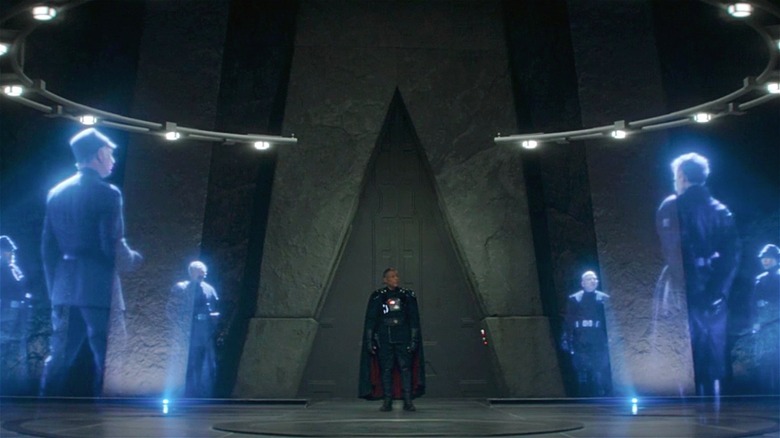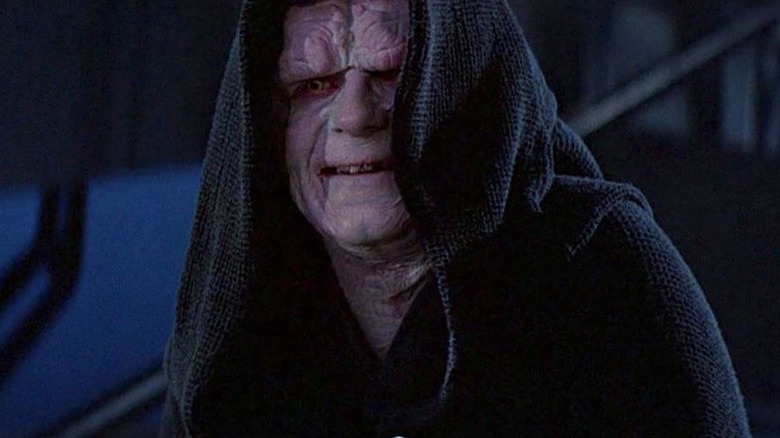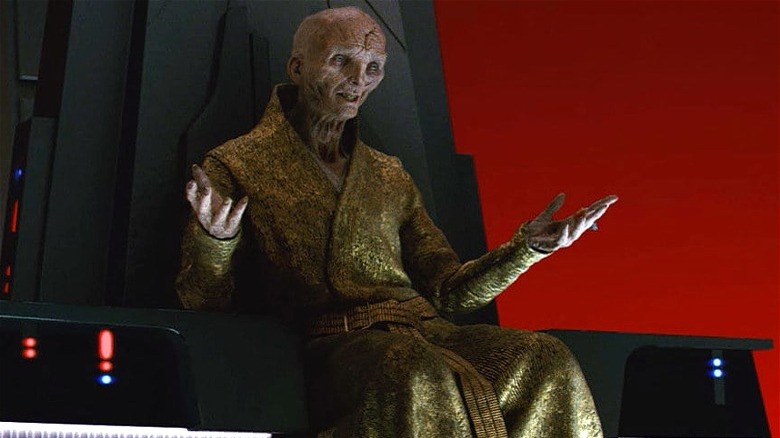What Is The Mandalorian's Mysterious 'Project Necromancer'? An Investigation
This post contains spoilers for Season 3, Episode 7 of "The Mandalorian," "The Spies."
After last week's languid, lighthearted episode in the latest season of "The Mandalorian," we have been treated to an extremely high-stakes penultimate episode meant to gear us toward an explosive finale. Delivering a cold open that strengthens the show's connections with the "Star Wars" sequel trilogy, Rick Famuyiwa's "The Spies" does not waste any time in setting up multiple future storylines in an attempt to fill in the gaps or fleshing out the canon.
We finally see Moff Gideon (Giancarlo Esposito) in the flesh after being teased about his return for six episodes, and the big baddie is busy conversing with the Imperial Shadow Council, who are working overtime to reinstate the Empire covertly. We see Admiral Pellaeon (Steve Pemberton), who has a direct connection to Grand Admiral Thrawn, along with Commandant Hux (Brian Gleeson), known to be key to the First Order and its eventual rise to power down the line. While these cameos already tie the events of "The Mandalorian" to that of the sequel trilogy, a mysterious, secretive project is namedropped to suggest the return of a familiar face.
Gideon and Commandant Hux briefly talk about cloning technologies, with the former evading questions about Dr. Pershing's fate and being dismissive about plans related to this field. This is when Hux mentions Project Necromancer, which everyone in the council seems to be aware of. While Hux and co. are most likely referring to Palpatine returning somehow, let us look into the many facets that might factor into this nefarious Imperial experiment.
Understanding Sith necromancy
While the Sith are known to walk a dark, dangerous path, incorporating arcane magic and alchemy, necromancy is still considered niche and mostly off-limits by disciples of this path. After all, reanimating the dead is no easy task, as it requires ritual magic and personal sacrifices that come at a great cost.
However, canon dictates the existence of Siths like Dathka Graush, who were among the earliest practitioners of Sith necromancy. Graush managed to perfect a spell that helped create a zombified army bound to him through the dark side of the Force, while he replaced his heart with a crystal to further amplify his connection to the dark side. Years after Graush's death, many Sith practitioners were desperate to learn more about the forbidden arts from the long-dead Sith King, going as far as disturbing his Korriban grave for answers.
There are many magic users spread across the galaxy — for instance, the Nightsisters of Dathomir tap into dark energies granted by the planet's ichor — but the act of bringing the dead back to life is a big no-no even for the most formidable magic users. While ritual necromancy might be a lost art to the remnants of the Empire in "The Mandalorian," it is not far-fetched to assume that some form of this idea is being implemented with the aid of advanced technology. Project Necromancer might be a combination of arcane magic and state-of-the-art technology, with several layers of objectives ranked according to priority. At the moment, the Empire is scattered and leaderless, which would make sense for the introduction of an interim puppet ruler sometime in the future, leading us to...
Snoke, and by extension, Palpatine
Events of the sequel trilogy map out the rise and fall of Supreme Leader Snoke (Andy Serkis), who acted as leader of the First Order in the New Republic era. After Kylo Ren (Adam Driver) betrays Snoke by killing him in "The Last Jedi," it is later revealed that he was only an artificial genetic construct created as a proxy until Palpatine's resurrection, with his only goal being manipulating events in favor of the Sith resurgence.
The opening of "The Rise of Skywalker" hints at several Snoke clones hibernating inside glass tanks, which could possibly mean they were all programmed to act a certain way, despite seeming to possess a mind of their own. The mechanics of cloning and artificial constructs in the sequels are murky at best, as we are never shown how Palpatine managed to return, but are instead treated to ascension schemes that abide by the Rule of Two. Kylo killing Snoke fulfilled the purpose of the last Skywalker sitting on the Sith throne, but Rey's (Daisy Ridley) decision to step up as "all the Jedi" thwarted this elaborate plan at the last minute. There are aspects of this plan that are shrouded in mystery, as Palpatine claimed that he was the one who created Snoke, and we might be offered a glimpse into how that came about.
Project Necromancer could be the Shadow Council's attempts to resurrect Palpatine while creating Snoke clones to keep edging towards their goal of establishing the First Order. Gideon seems to be in on it, but his latest display of forced leadership might point at potential tensions between and anyone who emerges as the supreme leader of this fascist superstructure.
An undead army
Gideon's interest in Grogu in the first two seasons of "The Mandalorian" ties in directly with the Empire's covert plans to champion genetic cloning and DNA reanimation. The Dr. Pershing episode reinforces these narrative strands, as he delivered a TED talk about the potential good that can come out of such experimental science, allowing dead loved ones to live on via DNA replication. Moreover, Elia Kane's presence on Coruscant also hints at a grander plan spearheaded by Gideon, wherein he has access to information about cloning that others in the Shadow Council might not be privy to.
But how does Thrawn factor into Project Necromancer, if at all? The Shadow Council seems to be confident of his imminent return, although Gideon, who is more power-hungry and ambitious than ever, does not seem too happy about this news. While Thrawn will most likely make his first live-action appearance in "Ahsoka," he is bound to be involved in the Council's plan to some extent. As Thrawn's hidden presence is the Empire's greatest wild card at the moment, it makes sense for the military strategist to pull the strings on a covert project involving the reanimation of the dead.
Could the Empire be seeking to bring back the dead in hordes? This is not a far-fetched idea, as Undead Troopers once existed in the galaxy, thanks to a viral outbreak. These troopers were infected with a viral agent that turned them into mindless killers after their deaths, and the group shared a hive mind and was able to sustain great damage. With thousands of stormtrooper casualties and dwindling Imperial forces, it is likely that Project Necromancer will focus on rebuilding an elite army of the dead that cannot be easily taken out with a blaster or the swing of a saber.



